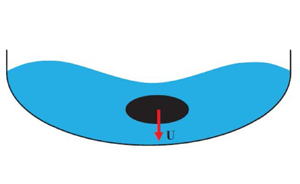No CrossRef data available.
Article contents
Impulsive impact of a body fully submerged in an open container
Published online by Cambridge University Press: 16 January 2023
Abstract

An impulsively starting motion of a cylindrical body submerged below a calm water surface in an open container of arbitrary shape is considered. This work generalizes the case of an infinite-depth liquid studied by Semenov et al. (J. Fluid Mech., vol. 919, 2021, R4). Particular attention is paid to the interaction between the body, the free surface and the container. The integral hodograph method is employed to derive the complex velocity potential in a parameter plane. The boundary-value problem is reduced to a system of integral equations, which is solved numerically. The velocity field, the pressure impulse on the body and the container wall and the added mass just after the impact are determined for a wide range of depths of submergence and container geometries and for various cross-sectional shapes of the body, such as a flat plate, a circle and a rectangle.
JFM classification
Information
- Type
- JFM Papers
- Information
- Copyright
- © The Author(s), 2023. Published by Cambridge University Press


